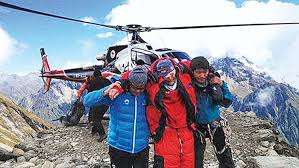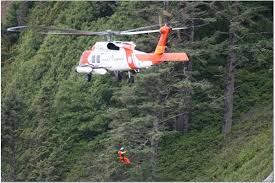CASE STUDY 1
A post New Year walk took place for those attempting to come to terms with their over-indulgence at Christmas 2015.
The walk was graded M although it contained some rough footpath downhill to the sea.
At a benign part of the walk a lady was unlucky enough to slip, fall and break her ankle. She was immediately in pain and the angle of her foot left no room for misinterpretation. Fortunately a retired GP was on the walk. She confirmed the diagnosis and the emergency services were called.
While waiting for almost an hour for a team from the police to arrive in order to make an assessment the patient was cold (partly from shock). Although it was a sunny day there was a stiff breeze blowing along the coast.
Once the police arrived they quickly summoned a helicopter and the patient was taken first to an ambulance at the beach and then to hospital. Her husband had to make his own way!
Lessons included:-
- Although not a cold day both patient and attendants quickly cooled. Additional clothing was vital. Quite a bit of this was given up to the patient so others might quickly get cold themselves!
- Emergency services will always want to assess the situation before action and this might entail a long wait.
- Mobile coverage was patchy. Contact was just about maintained but it might have been necessary to walk out to summon help or at least to get mobile coverage. The charge in the mobile was adequate and others were turned off in case of later necessary use.
- Most participants continued safely to finish their walk and only those required to provide help remained with the patient. It might have been necessary to carry her further.
- All who remained with the patient had sufficient food and water.
- Somebody in the party who remained with the casualty knew the way to get back safely.
CASE STUDY 2
A man who walked regularly with the CBMW and his wife took a holiday in S. Africa, part of which was dedicated to walking in some of the local mountains.
During a strenuous day of walking they summited a peak of some 3000m. On the way down he tripped and fell some 3m and was briefly unconscious.
His injuries included a head wound and bad lacerations to his left hand which made it impossible for him to scramble down further.
Fortunately there were others in the immediate vicinity who were able to offer help.
After lengthy conversations with the emergency services he was winched off and taken to hospital.
Lessons included:-
- The couple were glad they had taken a first aid kit but had not checked it recently. Scissors were not present!
- Extra clothing was used. Patient shock meant this was essential and the long wait made it more so.
- They were glad that both of their mobiles were fully charged for fairly lengthy conversations with emergency services and that they did not run out of credit on their PAYG phones.
- Although many countries have Advanced Mobile Location, not all do and so it is helpful if you have an app on your smartphone to tell you your Lat and Long coordinates so that you can give them to the emergency services.
- They had bright clothing which made it easy for the arriving helicopter to see them and they made sure that all loose items were secure as the helicopter came in to land.
In both these cases there was a happy ending. Make sure that you are properly prepared before you venture out in the mountains.

